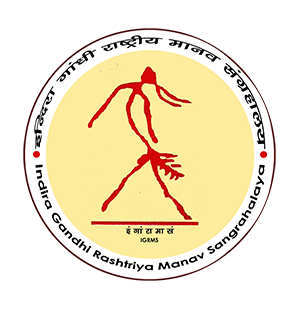भील
जिलाः झाबुआ
राज्यः मध्यप्रदेश
संकलन वर्ष: 2002
भील मध्यप्रदेश के धार, झाबुआ, खरगौन तथा रतलाम जिलों और पड़ोसी राज्य महाराष्ट्र, गुजरात और राजस्थान के सबसे पुराने निवासी है।
‘भील’ शब्द तमिल भाषा के ’विल’ अर्थात धनुष अथवा ’विल्लोर’ अर्थात धनुषधारी से लिया गया है। भील पुरूष सामान्यत: धनुष बाण रखते है। ‘धनुष’ अधिकांश जनजाति समूहों का लाक्षणिक शास्त्र होता है । वे पहले शिकारी हुआ करते थे किन्तु अब खेती करते है। वे भीली भाषा एक इण्डो आर्यन भाषा बोलते है।
भील आवास मुख्यतः जल स्रोत्रों के समीप की ऊपरी पर एक समूह या पंक्ति में दिखाई देते है। सामान्यतः आयताकार कमरे वाले इनके घरों में बड़े कमरे एवं अटारी का समावेष होता है। जिनकी दीवारें बांस की खपच्चियों पर गोबर, मिट्टी तथा घास के मिश्रण से पलस्तर कर बनाई जाती है। साधारणतया इनके घरों में एक मुख्य द्वार होता है लेकिन कहीं-कहीं पर पिछले द्वार भी पाए जाते हैं जिनका उपयोग घर के सदस्य करते हैं। छत के नीचे जमीन से 6 फीट की उँचाई पर एक अटारी होती है जिसका उपयोग की घरेलु उपयोगी वस्तुओं एवं अतिरिक्त सामान रखने के संग्रह के लिए किया जाता है । घर के सामने या बाहरी दीवार पर भित्ति चित्र बनाकर उसे सजाया जाता है जिसमें धनुष एवं तीर सहित मानव, पक्षी, बाघ, तेंदुआ इत्यादि को चित्रित किया जाता है ।
मध्य प्रदेश के भीलों की समृद्ध सांस्कृतिक परम्परा उनके अनुष्ठानों, गीतों, नृत्य, उनके देवताओं, गोदना, मिथकों और लाकगाथाओं में रूपायित होती है। मिट्टी को उकेर कर (क्ले रिलीफ) और चित्रांकन से सजी उनके घरों की लिपी हुई दीवारें उनके स्वाभाविक सौन्दर्य बोध का आभास कराते है। घर तीन भागों में विभाजित रहते हैं एक हिस्सा मवेषियों को रखने, दूसरा हिस्सा बच्चों के खेलने के लिए तथा तीसरा हिस्सा खाना पकाने, षयन एवं वस्तुओं के संग्रहण हेतु उपयोग किया जाता है। अन्नागार, घर को रसोई एवं बैठक घर में बांटने का कार्य करता है । घर के सामने के आंगन में घास के संग्रहण हंतु लकड़ी का चबूतरा बनाया जाता है । किसी भी शुभ दिन को गणपति एवं बजरंग भगवान की पूजा में नारियल अर्पित कर ये निर्माण कार्य प्रारंभ करते हैं। भगवान शिव उनके सर्वोच्च देवता माने जाते है। पूर्वजों की आराधना भी बहुत लोकप्रिय है। भगवान शिव की पूजा के अतिरिक्त वे वन देवी और बुरी आत्माओं को भी प्रसन्न करते है।
BHIL
Dist.: Jhabua
State: Madhya Pradesh
Year of collection: 2002
The Bhils are the oldest inhabitants of Dhar, Jhabua, Khargone and Ratlam district of Madhya Pradesh, neibouring states of Maharastra, Gujarat and Rajesthan.
The name ‘Bhil’ has been derived from the word Billee/billu means Bow. The bow is the characteristic weapon of the tribe. They speak Bhili an Indo Aryan language. The Bhil men usually carry bow and arrows. Bow is the charectoristic weapon of the tribe. Earlier they were great hunter now they practice agriculture. The Bhil house type occurs mainly on the upland near some streams arranged in groups or in rows. A Bhil house is generally rectangular in shape consisting of a spacious room and attic. The walls are raised with bamboo splits plastered with a mixture of cowdung, mud and chopped straws. Usuallly Bhil house have only a front door and in some cases a rear door is also found which is used by the inmates of the house. There is an attic of about 6 ft high from the ground and beneath the roof. It is used for storing household and other surplus items. The front wall of the house is decorated ith wall reliefs. The motives of men with bows and arrows, birds, igers, panthers etc. are generally prepared on the walls. The rich cultural tradition of the Bhils of Madhya Pradesh is manifested in their rituals, songs, dances, their daities, tattoes, myth and folklore. Their homes reveal an innate sense of aesthetics, walls as plastred and decorated with clay relief work and pantings. The hut is divided into three parts, one part is used as cattle shed another for lulling the baby and third part is used for storage, cooking and sleeping. Granaries are made to separate the part of house into kitchen and living room. A courtyard in front of the house has a raised wooden platform for storing grass. On the auspicious day they worship, Ganapati and Bajrang by offering coconut before starting construction. Lord Shiva is considered the suprime god. Ancestor worship is also quite popular. They appease deites of forest and evil spirits beside pujas of lord Shiva.
They are very much fond of dance and music with traditional tune of flute and drum.



